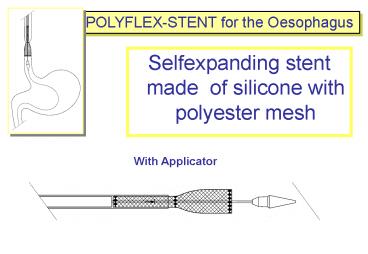With Applicator - PowerPoint PPT Presentation
1 / 48
Title:
With Applicator
Description:
hinders bolus obstruction. POLYFLEX-STENT for the Oesophagus. Characteristics. mesh geometry ... Food bolus impaction. Reflux. Esophagitis Fever. Edema Fistula ... – PowerPoint PPT presentation
Number of Views:100
Avg rating:3.0/5.0
Title: With Applicator
1
With Applicator
- Selfexpanding stent made of silicone with
polyester mesh
2
Package contents
Esophageal stent
Applicator sleeve
Stent loader
Guide Tube with Dilator tip
Soft positioner
Stopper
Fixation Aid
Instruction for use and Patient-Labels
3
Indications
- Maintaining esophageal luminal patency in
esophageal strictures caused by intrinsic and/or
extrinsic malignant tumors - Occlusion of malignant esophagotracheal/-bronchial
fistulas
4
(No Transcript)
5
(No Transcript)
6
Contraindications 1
- Serious blood clotting disorders
- Not treat4ed primary tracheal stenoses which
would deteriorate using esophageal intubation - Non controllable secondary tracheal stenoses
arising during esophageal intubation
7
Contraindications 2
- Extremely narrow and rigid stenoses which cannot
be widened sufficiently through dilation - stenoses which are located extremly high
(proximal end of stent less than 2 cm distal from
the esophagus-opening - Patients, with whom endoscopic techniques cannot
be performed and/or are contra-indicated
8
Available Sizes
9
Characteristics
- Silicone coating throughout
- prevents ingrowth of tumour tissue
- closes tracheo-oesophageal and broncho-oesophageal
fistulae
10
Characteristics
- Mesh structure of the outer surface of the stent
- increases security against dislocation
11
Characteristics
- Smooth inner surface
- hinders bolus obstruction
12
Characteristics
- mesh geometry
- optimized radial force
- easier application of the stent
- adapts elastically to the anatomy of the
oesophagus
13
Characteristics
- The stent narrows under tension
- allows simple change of stent
14
Characteristics
- Thin wall
- suitable for stent-in-stent insertion
15
Characteristics
- Funnel-shaped proximal end
- helps to prevent distal dislocation
16
Characteristics
- Broad range of widths and lengths
- can be coordinated for each indication and
anatomical situation
17
Characteristics
- Radiopaque insertion set
- facilitates precise positioning and monitoring of
use
18
Characteristics
- Silicone reinforcement protects the edges
- less stimulation for granulation
19
Characteristics
- markers for X-ray and endoscopic controll
- improved visibility during placement and
post-operative follow-up
20
Selection of stent size - Diameter
- The selected stent diameter must be individually
calculated and will depend upon the given
anatomic conditions
21
Selection of stent size - Length
- The stent must always be 3 4 cm longer than the
stenosis, so that it extends the stenosis at
least 1 2 cm at both ends of, thus minimising
the risk of tumor overgrowth. ! - Do not shorten the Polyflex stent!!
22
Loading the stent (1)
- Insert the stent about halfway into the basket of
the applicator as far as the marker
23
Loading the stent (2)
- Pull the stent with the basket into the
introducer sleeve, stretching the stenttogether
with the basket in order to achieve a narrowing
of the funnel-shaped stent end.
24
Loading the stent (3)
- Pull the stent in until only about 1 mm of it
projects from the transparent introducer sleeve
25
Loading the stent (4)
- Use the stopper to secure the stent in the
introducer sleeve so that it cannot be inserted
any further
26
Loading the stent (5)
- Pull the loader off the stent by pulling it
backwards with an even movement
27
Loading the stent (6)
- Push the stent with the aid of the
soft-positioner into the introducer sleeve up the
marker
28
Loading the stent (7)
- Pull the guide tube with dilatior-tip through the
loaded stent - The soft-positioner is pushed onto the guide-tube
and into the applicator-sleeve
29
Application of the stent (1)
- The guide-wire is in place
- fed the guide-wire through the dilator-tip and
the guide-tube - place the application-system with the stent in
the centre of the tumor
30
Application of stent (2)
- The transparent introducer sleeve is held at its
upper end with the reinforced netting and is
withdrawn over the positioner - Do not push the soft-positioner forwards - it
must be held in position!
31
Removal of the stent
- The Polyflex stent narrows under traction.
- Because of this, the stent can be removed with an
atraumatic foreign body forceps by pulling it
back slowly and carefully
32
Questions and Answers 1
- The POLYFLEX-STENT can be withdrawn proximally
under careful traction
- ???
- The POLYFLEX-STENT is placed too distally...
33
Questions and Answers 2
- Pushing the POLYFLEX-STENT distally is not
advisable because of the particular material
characteristics of the netting material
(squashing). - Remove it and place it once more.
- ???
- The POLYFLEX-STENT is placed too proximally ...
34
Questions and Answers 3
- NO! Do not shorten the POLYFLEX-STENT.(risk of
damage by projecting netting fibres).
- ???
- Can I shorten the POLYFLEX-STENT?
35
Questions and Answers 4
- NO! Protect POLYFLEX-STENT from direct laser
bombardment. - Magnetic resonance imaging and CT are possible
- ???
- Can I use laser while the POLYFLEX-STENT is in
place?
36
High grade distal stenosis
37
Applicator-Sleeve with loaded Stent
38
Released Stent with Guide Tube
39
Dilator-Tip is pulled back through the Stent
40
Stent in place
41
Potential Complications
- The following complications have been reported in
the literature for esophageal prostheses - Procedural Complications
- Perforation
- Aspiration
- Bleeding
- Stent migration
- Pain
42
Potential Complications (ctd.)
- Post-Stent Placement Complications
- Perforation
- Bleeding
- Stent migration
- Pain
- Tumor Overgrowth around ends of stent
- Food bolus impaction
- Reflux
- Esophagitis ? Fever
- Edema ? Fistula
- Ulceration ? Septicemia
43
(No Transcript)
44
(No Transcript)
45
(No Transcript)
46
COMPETITION
COOK-ZSTENTS
- GIANTURCO-RÖSCH COVERED ESOPHAGEAL DESIGN
- Cook
47
COMPETITION
- Flamingo
- covered conical esophageal Wallstent
- Schneider/Boston
48
COMPETITION
- Ultraflex
- Nitinol
- covered and
- uncovered version
- Boston
- Scientific
- MICROVASIVE































